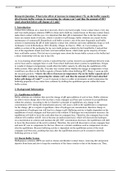Essay
HL Chemistry IA (7)
- Module
- Chemistry IA
- Institution
- International Baccalaureate
This is my final Chemistry HL IA essay submitted to the IBO for the May 2019 session. I achieved a 7 for this essay and was awarded 44 points in total for the IB diploma.
[Show more]



